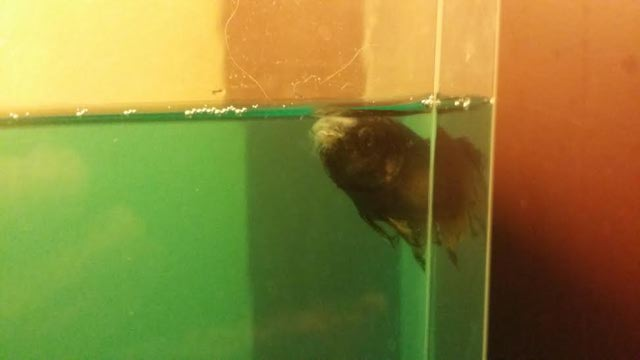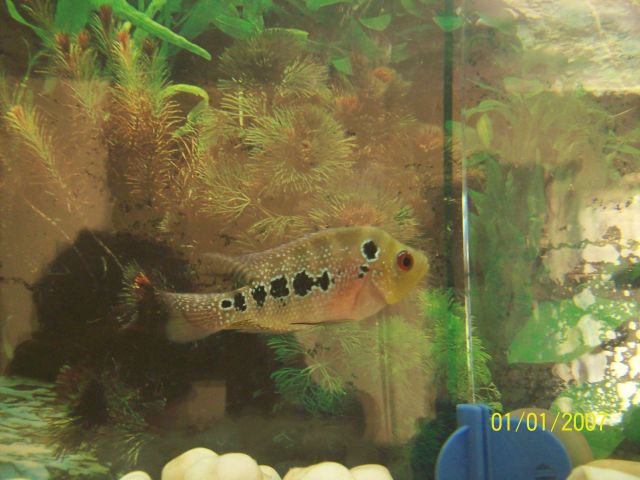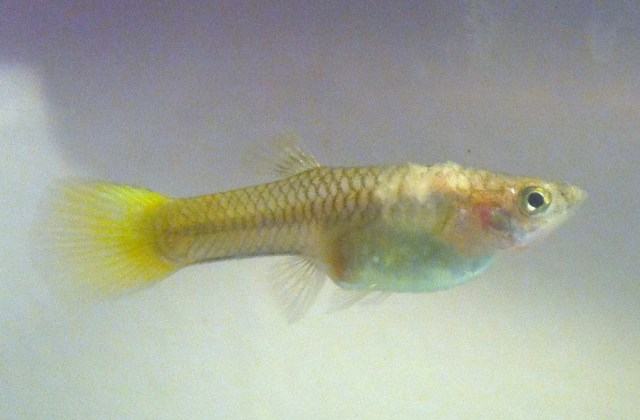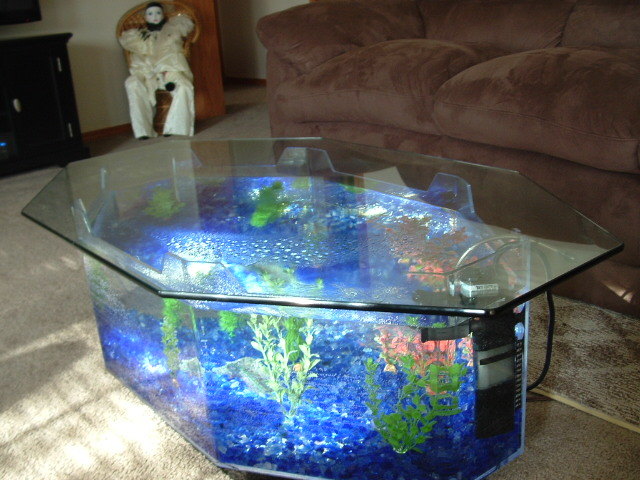QuestionQUESTION: Hi Susan: I've read through a lot of your Q&As to find my answers and I think I have done quite well with helping my son's Comet GF back to stable health. My situation is very similar to the person with a sick Fan Tail that wrote you back in 4/3/2006. I don't think I am quite out of the woods yet and had a couple more questions.
My son's Comet Goldfish (Swimmy) was starting to get listless, his fins were stiff, his dorsal fin clamped shut and he was hanging around at the top of the tank. I admit, I had been guilty of letting his water quality slip, and had not done the proper water changes with the frequency necessary. Swimmy's body is about 4" in length (not including his long tail). We have had him about 2 years. Swimmy's home is a 6.6 Gallon aquarium. He is the only fish in the aquarium. The filter is the original 10 Gallon filter that came with the aquarium. It uses disposable carbon media.
I took the advice you gave the person from 4/3/2006 immediately did a 50% water change and have been treating the aquarium with Pimafix and Melafix. I added a bubbler to his tan, I added the proper amount of aquarium salt to his tank (I had never used this before) and I added a multi-purpose bio-support to his tank. I have also added a few blood worms to diet (in addition to his normal flake food) - being careful to make sure he eats all the food I add to the tank.
It has been 2 1/2 days since I started this process. Swimmy has come back nicely. He is active, his fins are no longer clamped shut and he is starting to look healthy again. Here are my remaining questions:
1) I turned off the filter as the medicine recommends. The medicine says to treat for 7 full days before making a 25% water change. This seems too long to me for my small tank. I was thinking of doing a partial 25% water change every 2 1/2 days continuing with the medicine for approx. 7 - 8 days. At the end of the treatment I planned to assess how Swimmy was doing. If he seemed back to normal I planned to start up his filter again and stop the medication. If not, I thought I would continue for another couple of days with the medicine. What are your thoughts on this?
2) How often do you think Swimmy's tank needs regular 25% water changes? I usually do them them once a week. Do you think this is frequent enough?
3) Every once in a while we do have to go out of town for an extended 2 week vacation. Usually I change 1/3 of the water the night before we leave, set up a automatic feeder and leave Swimmy where he can get some natural light through the day. What do you think is the best way to handle vacation situations?
4) I do not have a heater in Swimmy's tank. From what I read it did not seem necessary. What are your thoughts on water temperature for Swimmy?
5) I have testing strips for Swimmy's tank, but am not sure what types of levels are appropriate for him and/or how often to check his tank with the test strips or if testing his tank is really even necessary.
Thank you in advance for your assistance. I have found the Q&As from you, and this sight in general, very helpful, as I stumble my way through keeping my son's Comet Goldfish healthy and happy.
ANSWER: Hi Carolyn!
I'm glad this site and my previous answers have helped you some with your little comet goldfish. :-)
I'll answer your questions in the order you asked -
1) Very smart thinking! Your aquarium is very much on the small side (for a goldie) and I'd definitely recommend a 50% water change every day on the tank and simply redose the medicine at half the dose. Swimmy will LOVE the extra clean water and it will boost his immune system.
Remember, you don't always have to turn off the filter during medicine treatment. The only reason for this is to prevent carbon filter media (that is often present in most filters) from absorbing the medication. Usually there is a way you can get rid of the carbon but leave the rest of the filter media and keep the filter running so the water can be circulated and oxygenated. *And also, at the end of the week when you assess Swimmy's condition.. If he still seems sickly you can extend the medication treatment for another week with no harmful effects. Pimafix and Melafix are very safe and gentle meds.
2)Goldfish are one of the those species that have a very high metabolism and are very big eaters. So in turn, they produce quite a high waste level or "bioload" and really need regular big water changes in order for them to grow and thrive. While goldfish can adapt and survive in less than ideal conditions, the best case scenario for them would be as frequent of water changes you can manage. Actually this goes for almost any species of fish. In nature fish don't normally have to deal with their own pollution. One of the best ways to estimate how often and what percentage you should change your goldfish's water is by testing the nitrate level (not to be confused with nitrite)... Nitrate is the final end product of the beneficial bacteria cycle. The good bacteria that first convert ammonia (produced by the fish) into nitrite and then later into nitrate. Ammonia and nitrite are both dangerous to fish. But nitrate is fairly safe unless it is allowed to build up. Its kept in check with water changes. The amount of nitrate in your aquarium can give a good estimate of the pollution level in your tank. You should aim to keep it as low as possible. Somewhere below 10ppm is ideal!
3)The good news is most fish handle vacations quite well. The most important thing to do is feed lightly a day or two before leaving and do at least a 50-75% water change just before you go. Automatic feeders are great to use but surprisingly many fish can go for two weeks without eating with no ill effects.
4) Heaters are in fact not necessary for goldfish. They frequently thrive in ponds all year round so room temperature is perfectly fine for them. Its also OK if it fluctuates slightly every so often. The only time I would worry is when doing water changes... you don't want to add really cold or really warm water back into his tank. Try to get it almost equal or at least very close to his tank's temp.
5) The most important levels to test for in aquariums are Ammonia, Nitrite and Nitrate. These levels should be as follows -
Ammonia- 0
Nitrite-0
Nitrate- 10 or less
Some sources will suggest monitoring the pH level but its really not necessary in most cases.
Generally, the best time to test your water is during times your fish seems stressed or the water is odd-smelling or discolored. The key here though is if you keep up with the maintenance of the tank with lots of water changes, you won't hardly ever have to worry about testing your tank's levels at all.
I really hope this helps and best of luck to Swimmy!
Let me know if you have anymore questions!
Susan~
---------- FOLLOW-UP ----------
QUESTION: Hi Susan: A quick update on Swimmy and a few more questions. Swimmy is doing really, really well. He is back to his active, curious self. I'm so relieved that he is improving and happy. I felt terrible about being a bad "fish Mom" and let him get sick due to unhealthy, dirty water. He is such a pretty comet GF. People are always amazed when I tell them my son picked him out of the "feeder" tank at the fish store.
Continued Treatment: As you suggested, I will do a 7 day treatment with the Primafix and Melafix, doing a daily 50% water changes, I'll continue to add aquarium salt (as appropriate) to the fresh water and I will cut the medication in half (to match the amount of fresh water I am adding to his tank). I have also started up the filter again, removing the carbon. Silly me! I never thought to do that!
Vacations: The suggestions you make for vacation care was very useful and gave me some things to think about. It sounds like dirty water is more harmful over less food for a 2 week time period. Plus, my thoughts are any food in the tank uneaten adds to the making the water all the more harmful to Swimmy. It doesn't happen all that often we have to leave for a 2 week vacation, but I always worry when we are away and if I can't find someone to check on Swimmy to make sure he is OK.
Here are my remaining questions:
1) I looked on my test strips and they do not have a test for Nitrate, Nitrate & Ammonia. Only Nitrate and Nitrite on the testing strips. It seems like they equate Nitrite with Ammonia on the bottle. Since I have never really monitored it, I was going to do it for a time to see if my once a week water changes are enough. If I need to up the frequency of the changes, I was going to use the test strips to help me judge that and I'm still a bit confused. On the parts per million scale (PPM) on the side of the bottle it lists "safe" Nitrate at 0, 20 & 40 and it lists "safe" Nirite at 0 and 0.5. Ideally, I guess I am shooting to keep the Nitrate between 0 & 20 and the Nirite at 0. I realize Ammonia should test at 0 -- I guess I need a different test kit?
2) In the two years we have owned Swimmy he has grown substantially. The tank he is in now is his second home. Swimmy quickly outgrew his first 2 1/2 gallon tank and I'm worried that this tank (6.6 gallons) is on the edge of getting too small. What are your thoughts on this?
3) When I change Swimmy's water I do try to be sure that it is similar in temperature to what is currently in his tank. I use our reverse osmosis water when I do the water changes. Some people have told me that they feel this water is too soft and I should use regular tap water instead. Do you have a preference?
4) Do you recommend the use of multi-purpose bio-support to tank water?
Thank you, again, for donating your time to respond to the questions on this forum. Your advice definitely saved my son's comet GF. I hope others have as successful an outcome as I was lucky enough to have.
Warm regards,
Carolyn
AnswerHi Carolyn,
Such wonderful news! I'm so glad Swimmy is doing better, and its all thanks to your good care and concern!
Its very true that even 'feeder' goldfish can grow into beautiful fish when given good care.
With vacations, you're right about keeping good water quality being far more important than feeding fish. If the automatic feeder doesn't put too much food in at one time and Swimmy has been fine other times you've had to go on vacation then it must be OK for him. Lets just hope it stays that way.
Question 1. (test strips)
Test strips are good to have to get a general idea of your water's levels but to be truly and more easily accurate the liquid test kits with the test tubes are a much better option. They come separate in individual tests versus in test strips sometimes the levels are combined in one strip. With liquid test kits you'll need one for ammonia, one for nitrite, and one for nitrate.
Given the fact that your aquarium has been setup for a good while now I don't feel its -vital- to have ammonia tests. Unless you simply want to have it on hand for emergencies. Usually the time you'd be testing for ammonia the most would be when you first setup a tank or if you are having battles with sickly acting fish or sudden nitrites. And again, by keeping up with the maintenance of the tank, it will be rare that you will have problems.
Questions 2 (Swimmy's tank size)
While Swimmy is doing OK in his 6.6 gallon. Soon he will need a bigger tank. Comet Goldfish can grow to 10-12 inches with good care! Take a look at this Comet goldfish photo for example - http://img.thesun.co.uk/multimedia/archive/00470/GB_BIGGEST_Goldfish_470456a.jpg
It may take a few years and lots of good care for a goldfish to reach the size of the one in the photo. But it is possible! Remember that one myth about goldfish growing to the size of the tank is simply not true! The ideal size tank for goldfish that have grown at least around 4-6 inches would be at least a 10-20 gallon. Typically the ratio of water per goldfish is ideally around 10-gallons per fish. Now that may have be increased a little more if there were many quite large goldfish. Again, nitrate level does play a factor in determining some of this. Swimmy could always benefit from a bigger tank... more swimming room, more dilution of the waste he produces all will help him thrive better and be healthier.
Question 3 (Using Reverse Osmosis water)
The reason people often don't recommend using RO water in fish tanks is because it can lack important minerals fish really need to be healthy. A much better option would be to start mixing in a little tap water with the RO water and eventually converting him over to full tap water (preconditioned of course) There's rarely anything wrong with using regular tap water. Its what I use for all my fish tanks. Some people often use a combination of RO and tap on a regular basis if they are trying to get a lower pH level for delicate wild caught species or for marine tanks.
Question 4 (Multi-Purpose Bio-support)
This product containing millions of beneficial bacteria is not entirely necessary to use constantly in a healthy aquarium. But since you do have it on hand it doesn't hurt to continue using it since your tank is going through a medication treatment and Swimmy could use all the help he can get. :-)
You're very welcome for everything! My job here is to try my best to help concerned fish owners like you through tough times and enable them to do what is best for their aquatic pets.
My best wishes to you,
Susan~

 Betta with Mouth Fungus?
Question
Sick?
Hi I have a male betta with mouth
Betta with Mouth Fungus?
Question
Sick?
Hi I have a male betta with mouth
 IS my flower horn male or female
Question
my flower horn
IS my flower horn male or femal
IS my flower horn male or female
Question
my flower horn
IS my flower horn male or femal
 betta tank
Question
my betta tank
hi jaymie, i have a betta tank w
betta tank
Question
my betta tank
hi jaymie, i have a betta tank w
 Sick female guppy
Question
Guppy fish
Hello, I am new to fish breeding an
Sick female guppy
Question
Guppy fish
Hello, I am new to fish breeding an
 airator
Question
25 gallon fish tank
i have a dive power submer
airator
Question
25 gallon fish tank
i have a dive power submer